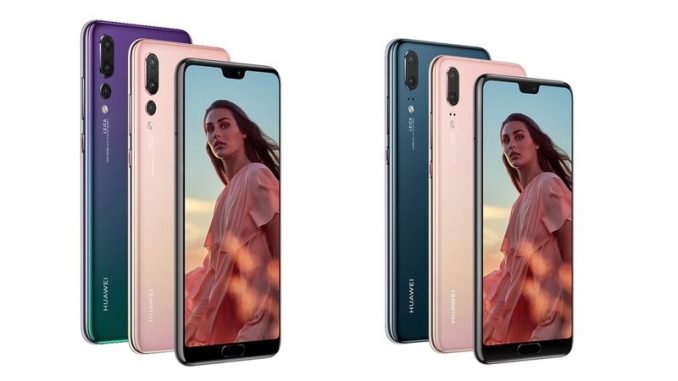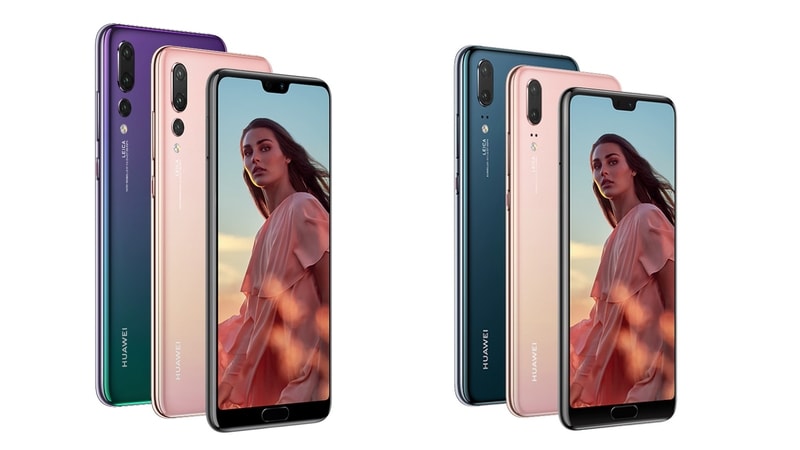

Huawei P20 and P20 Pro smartphones have been launched by the Chinese brand at an event in Paris, bringing yet another pair of camera-focused handsets to the market. Huawei said its new P20-series smartphones feature AI-powered camera features, with the optics ‘co-engineered’ with Leica. Huawei Consumer Business Group CEO Richard Yu at the event said the company skipped the P11 moniker and jumped straight to P20 as the latest models had major improvements over the previous generation. Yu also revealed a new logo for the company.
Yu at the event also spoke about the design aesthetic of the new Huawei P20 and P20 Pro smartphones, claiming they have ‘seamless surfaces’ to touch, and highly symmetrical form factor to see. The colour of the smartphones was also looked at closely, Yu said, with ‘nature-inspired’ pearlescent effects giving the phone a different colour depending on the angle it was viewed from. Both phones will be available in four colour variants – Graphite Black, Midnight Blue, Pink Gold (gradient colours), and Twilight (gradient colours). Each comes with different, colour-matched themes.

Huawei P20, P20 Pro price
The Huawei P20 price has been set at EUR 649 (roughly Rs. 52,200), while the P20 Pro price has been set at EUR 899 (roughly Rs. 72,300). Both smartphones are said to be immediately available globally, but we can expect more details on this front in the near future. To recall, the company had unveiled the Huawei P20 Lite earlier this month in several European markets, so we already know all about it.
Huawei P20, P20 Pro specifications and features
Both the Huawei P20 and P20 Pro are dual-SIM smartphones that run EMUI 8.1 based on Android 8.1 Oreo. They also support Google ARCore and a deeply customised Google Assistant. Both smartphones are also powered by the octa-core Huawei HiSilicon Kirin 970 SoC (four Cortex-A73 cores clocked at 2.36GHz and four Cortex-A53 cores clocked at 1.8GHz) complete with a dedicated NPU (neural processing unit). The NPU provides the AI chops to the phone, and is also said to provide up to 60 percent better system response speed, and up to 50 percent smoother operation. It also offers AI-based noise removal on call. The company also touted NPU acceleration for Android Messages, the new Google-made RCS-based default messaging app on the Huawei phones. The Huawei P20 has 4GB of RAM, while the P20 Pro has 6GB RAM. Both have 128GB of inbuilt storage. Both phones come with a 360-degree Face Unlock feature, said to unlock the smartphones in as little as 0.6 seconds.

Twilight Blue colour variant on the Huawei P20 Pro
The Huawei Share 2.0 feature was also launched, for easy sharing between phones and even PCs (Windows and Mac) with up to 96Mbps transfer speeds over Bluetooth and Wi-Fi. Another new feature is the Huawei Phone Clone app, that helps users migrate between smartphones. Also new is the Huawei Health app, which features TruScreen heart rate monitoring, TruSleep technology, and secured fitness data cloud storage. The Huawei PC Mode, similar to the Samsung DeX platform, lets users connect their P20 and P20 Pro smartphones to a monitor to replicate a PC-style experience that helps multi-task, use multiple windows at the same time, apart from emulating a keyboard and touchpad on the smartphone itself. Finally, the P20 and P20 Pro come with wireless Hi-Fi audio, with HWA (Hi-Res Wireless Audio), providing 990Kbps bandwidth over Bluetooth. The company has partnered with audio device manufacturers such as Sennheiser, Audio-Technica, and Onkyo to build the HWA ecosystem. Both smartphones also feature stereo speakers with Dolby Atmos and Dolby AC-4 audio.
The Huawei P20 sports a 5.8-inch full-HD+ (1080×2244 pixels) RGBW FullView display, with the W standing for White, and meant to provide better sunlight legibility. The display is said to have a peak brightness of 770 nits, which Huawei says is 23 percent brighter than iPhone X. The white elements are also said to provide better power consumption. The company also said the P20 has same size of display as the Samsung Galaxy S9 and the iPhone X, however, it is said to have significantly larger display real estate thanks to smaller bezels and the smaller ‘notch’ design. It also sports a home button that supports ‘edgeless fingerprint’. There is also gesture support on the home button, such as short tap for back, long tap for home, and swiping left or right for multi-tasking.
The Huawei P20 Pro sports a 6.1-inch full-HD+ (1080×2240 pixels) OLED FullView display, said to have a 1:1,000,000 contrast ratio and a 105 percent colour gamut. Both smartphones are said to have ‘natural tone displays’, comfortable for all light conditions. It otherwise bears the same home button, bezel, and notch design as the P20.
Huawei says the P20 has an IP53 rating for dust and water resistance. It runs on a 3400mAh battery, despite being just 7.65mm thick, the company said, providing up to 75 hours of continuous music playback. The Huawei P20 Pro on the other hand has an IP67 rating for dust and water resistance, and is powered by a 4000mAh battery despite being just 7.8mm thick, providing up to 89 hours of music playback. Both batteries support Huawei SuperCharge fast charging that is said to deliver 58 percent in just 30 minutes. It is also said to be a safe fast charging method.

Huawei P20 dual rear camera setup
The Huawei P20 has dual rear camera setup with large 1.55-micron pixels, featuring a 12-megapixel RGB 1/2.3-inch sensor coupled with an f/1.8 aperture and a 20-megapixel monochrome sensor coupled with an f/1.6 aperture (VARIO-SUMMILUX-H 1:1.6/27 ASPH). The combination gives it superior low-light photography performance, the company said. On the front, the Huawei P20 sports a 24.8-megapixel camera. The company is touting front camera features that help take better selfies. The smartphone also comes with a 3D portrait lighting effect. Huawei cites DxOMark to say the P20 has the best smartphone camera ever, with an overall score of 102, a photo score of 107, and a video score of 94, beating out the iPhone X and the Samsung Galaxy S9. Shortly after, Yu revealed the P20 Pro has even better DxOMark scores, with an overall score of 109, a photo score of 114, and a video score of 98.
Coming to the highlight of the launch, is the triple rear camera setup of the Huawei P20 Pro. The topmost lens bears an 8-megapixel sensor with 3x optical zoom thanks to its Leica telephoto lens (VARIO-SUMMILUX-H 1:1.6-2.4/27-80ASPH). The second, bears a 40-megapixel RGB 1/1.7-inch sensor, while the third bears a 20-megapixel monochrome sensor. Between the larger lenses, lie a laser transmitter and receiver, for quicker autofocus, as well as a Leica colour temperature sensor. The camera has a light sensitivity up to ISO 102400 – the same as the Canon 5D Mark IV, the company says. This gives it even better low-light performance than the P20, even at 1 lux. The company is also touting the most powerful zoom on a smartphone, as apart from 3x optical zoom, the P20 Pro offers 5x lossless hybrid zoom, and 10x digital zoom. It has the same front camera as the P20.

Huawei P20 Pro triple rear camera setup
Both the P20 and P20 Pro offer 4D Predictive Focus, said to provide instant focus with motion prediction, providing nearly ‘zero shutter lag’, Huawei said. The smartphones support 6-axis stabilisation and 960fps super slow motion video recording. The company has also ensured that you can get to the camera as fast as possible, going from “screen-off to shoot” in as little as 0.3 seconds. Both phones also offer ‘Master AI’ scene recognition, with the company boasting of recognition for over 500 scenarios in 19 categories. There is also AI-Assisted Composition, to help with things like alignment and framing.
Alongside, Huawei launched its Apple AirPods clone, call Huawei FreeBuds. They are wireless earbuds that have their own charging case, and offering 10 hours of playback when fully charged. At the event, the company also launched the Huawei Active Noise Cancelling Earphones.
[“source=gadgets.ndtv”]
